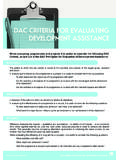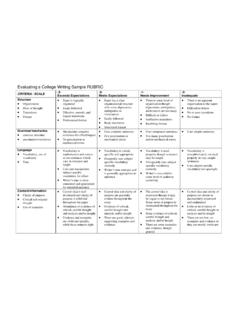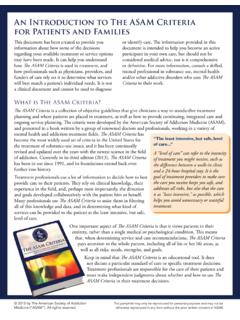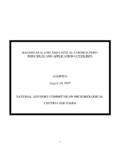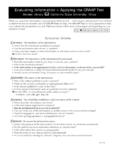Transcription of AF C EVALUATING C EMERGENCY NURSES
1 AFRAMEWORK FORCREATING ANDEVALUATINGCOMPETENCIES FOREMERGENCYNURSESA uthors:Andrew D. Harding, MS, RN, CEN, NEA-BC, FACHE, FAHA, FAEN, Gayle E. Walker-Cillo, MSN/Ed, RN,CEN, CPEN, FAEN, Allison Duke, BSN, MBA, RN, CEN, Gabriel J. Campos, MSN, RN, CEN, CFRN, CPEN, andStephen J. Stapleton, PhD, RN, CEN, New Bedford, MA, Morristown, NJ, Redlands, CA, Chicago and Normal, ILSection Editor:Nancy McGowan, RN, PhDNurses have a duty to the public, their profession,and themselves to maintain and demonstratecompetence throughout their of patients access health care through the emergencydepartment, placing increased importance on ED NURSES tomaintain competencies. However, a consensus definition andmethodology to maintain clinical competence remains is an intangible construct that is not a specific skillor task to be completed but rather is a necessary characteristicrequired to act effectively in a nursing and health care agencies struggle to demonstrate anddocument competencies, often relying on skill checklists,return demonstrations, portfolios, and certifications.
2 The pur-pose of this article is to discuss the development of competen-cies and provide examples of competencies for NURSES to use intheir quest to maintain and demonstrate clinical of Medicine s Call for CompetenciesEfforts in the United States to promote competency toensure that citizens receive safe, high-quality health careare anchored byHealth Professions Education: A Bridge toQuality, a report by the Institute of Medicine (IOM).3 The authors of this IOM report successfully called healthcare professionals, regulatoryagencies, and legislators toaction to demonstrate quality health care. The emphasison validating quality by decreasing medical errors, main-taining continuing education, providing patient-centeredcare through implementation of interdisciplinary teams,and instituting evidence-based practices is evident through-out the health care 2009, the IOM releasedRedesigning ContinuingEducation in the Health Professions,4which illustrates cur-rent concerns related to continuing education.
3 Proposedsolutions include providing a system of continued profes-sional development (ie, education and training after licen-sure), thereby promoting collaborative, learner-centered,effective, and valuable lifelong learning. Most recently theIOM publishedFuture of Nursing: Leading Change, Advan-cing Health,5a blueprint to improve the nursing report includes the following 4 key messages:1. NURSES should practice to the full extent of their educationand NURSES should achieve higher levels of education and train-ing through an improved education system that promotesseamless academic NURSES should be full partners with physicians and otherhealth care professionals in redesigning health care in theUnited Effective workforce planning and policy making requirebetter data collection and information `The profession of nursing is called to change the sys-tem within which we practice. Nursing is encouraged toadapt and provide leadership to meet or exceed increasedhealth care consumer demands.
4 Additionally, nursingneeds to transform professional educational processes toincorporate lifelong learning and demonstrate continuousclinical competence. As a profession, it is necessary toincrease our legislative influence to lead regulatory reformwhile continuously providing our nursing colleagues withcurrent research and evidence-based practices that lead toimproved, safe health D. Harding,Member, Mayflower Chapter, is Associate Chief Nur-sing Officer, Southcoast Hospitals Group, New Bedford, E. Walker-Cillo,Member, New Jersey ENA, is Clinical nurse Specialist,Morristown Memorial Hospital, Morristown, Duke,Member, California ENA, is Manager of EMERGENCY Services,Redlands Community Hospitals, Redlands, J. Campos,Member, Illinois ENA, is Clinical nurse Educator, TheUniversity of Chicago Medical Center, Chicago, J. Stapleton,President, Illinois ENA, is Assistant Professor, Menno-nite College of Nursing at Illinois State University, Normal, correspondence, write: Andrew D.
5 Harding, MS, RN, CEN, NEA-BC,FACHE, FAHA, FAEN, Southcoast Hospitals Group, Patient Care Services,101 Page St, New Bedford, MA 02740; Emerg Nurs 2013;39 online 8 November $ 2013 EMERGENCY NURSES Association. Published by Elsevier rights PRACTICE252 JOURNAL OF EMERGENCY NURSINGVOLUME 39 ISSUE 3 May 2013 ENA s Movement Toward CompetenciesThe ENA documentEmergency Nursing: Scope and Stan-dards of Practice6provides a strong foundation for profes-sional NURSES to recognize and understand the currentpractice and professional standards for EMERGENCY Scope and Standards document also meet the call toaction provided by the IOM reports, particularly from theFuture of Nursing: Leading Change, Advancing NURSES may use the ENA documentEmergencyNursing: Scope and Standards of Practice6when developingcompetencies. This documentprovidesdirectionfortheapplicati on of the scope and standards related to emergencynursing competence, competency creation, competenceassessment, and of CareThe term standard of care is defined by the state(s) inwhich the registered nurse (RN) is licensed.
6 Standard ofcare is used to determine the acceptable practices of a nursethat would be considered reasonable and prudent by othernurses within the applicable nursing the Uni-ted States, individual states create and interpret laws thatguide the scope of practice and standards of care for profes-sional registered NURSES (ie, nurse practice acts).8 ENAembraces a broad view toward scope and standards of emer-gency NURSES both at the domestic and international is essential that every EMERGENCY nurse know and practicewithin the licensee s state regulations and within theirrespective nurse practice act. ENA sEmergency Nursing:Scope and Standards of Practicedocument steers profes-sional NURSES to recognize and understand the current prac-tice standards for EMERGENCY created theEmergency Nursing: Scope and Stan-dards of Practicedocument6to demonstrate the rigor andindependence of EMERGENCY nursing as a specialty withinthe nursing profession.
7 In 2011, the American NursesAssociation (ANA) formally recognized EMERGENCY nursingas a specialty nursing practice. To be recognized as a speci-alty nursing practice, several criteria are required to demon-strate achievement of this goal (Table 1). TheEmergencyNursing: Scope and Standards of Practicedocument isviewed as the definitive resource regarding the standardsof care, standards of professional practice, and related com-petencies for EMERGENCY the competencies listed within theEmer-gency Nursing: Scope and Standards of Practicedocument6are not all inclusive, it is necessary for RNs to evaluateTABLE 1 American NURSES Association nursing specialty designation criteriaTo be recognized as a specialty, the American NURSES Association requires that the following criteria be nursing specialty: Defines itself as nursing. Is clearly defined. Has a well-derived knowledge base particular to the practice of the nursing specialty.
8 Is concerned with phenomena of the discipline of nursing. Subscribes to the overall purposes and functions of nursing. Can identify a need and demand for itself. Adheres to the overall licensure, certification, and education requirements of the profession. Defines competencies for the area of specialty nursing practice. Has existing mechanisms for supporting, reviewing, and disseminating research to support its knowledge base andevidence-based practice. Has defined educational criteria for specialty preparation or graduate degree. Has continuing education programs or other mechanisms for NURSES in the specialty to maintain competence. Is practiced nationally or internationally. Includes a substantial number of registered NURSES who devote most of their professional time to the specialty. Is organized and represented by a national or international specialty association or branch of a parent , American NURSES Association.
9 (2010). Recognition of a nursing specialty, approval of a specialty nursing scope of practice statement, and acknowledge-ment of specialty nursing standardsof practice. Silver Spring, MD: Authors. Used with Accessed November 18, et al/EVIDENCE-BASED PRACTICEMay 2013 VOLUME 39 ISSUE practice environment and implement competenciesbased on the standards and safety within the context oftheir EMERGENCY nursing practice. Additionally, theEmergency Nursing: Scope and Standards of Practicedocu-ment is beneficial for the creation of job descriptionsand institutional policies, procedures, and NURSES should expect, and be provided with,clear expectations regarding their nursing practice basedon these standards and job descriptions from theirrespective PoliciesOrganizational policies are directions provided to employ-ees that relate to nursing practice and employee behaviorwithin that institution. Policies typically are used to inter-pret, describe, and inform health care providers abouthow to perform processes or procedures within the con-fines of law, best practice, and professional with organizational policies places thehealth care provider at risk for litigation, discipline,and/or termination by acting outside of the local stan-dards of of CompetenceANA s position statement on professional role compe-tence10is a beacon for all NURSES to shine a light on theterm and function of competence in nursing defines competence as an expected and measurablelevel of nursing performance that integrates knowledge,skills, abilities, and judgment, based on established scienti-fic knowledge and expectations for nursing practice.
10 11 Subsequently, ENA6defines competence as the habitualand judicious use of communication, knowledge, technicalskills, clinical reasoning, emotions, values, and reflection indaily practice for the benefit of the individual and commu-nity being served. Each of these definitions seeks toFIGURE 1 The foundation of competence forthe EMERGENCY registered , American NURSES PRACTICE/Harding et al254 JOURNAL OF EMERGENCY NURSINGVOLUME 39 ISSUE 3 May 2013advance professional practice and professional practicemeasurements. The major themes of these 2 definitionsare woven into theEmergency Nursing: Scope and Standardsof Practicedocument, which utilizes the term competen-cies to provide measurable and expected behaviors foremergency nursing practice in relation to each correspond-ing RNs are responsible and accountable formaintaining professional competence and practicing ,8,11 ENA sCode of Ethics12specifically states thatthe duty of the EMERGENCY nurse is to maintain compe-tence within, and accountability for, EMERGENCY nursingpractice.

